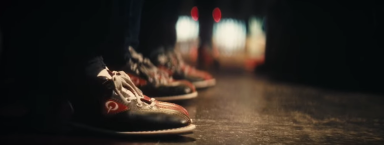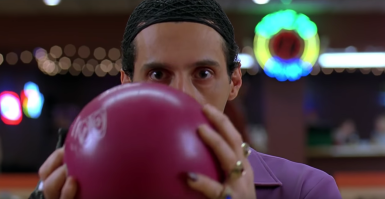Absent
Absent is a short film of 5:00 minutes that includes a narrative twist.
Short films referenced
Curfew (Shawn Christensen, 2012) 19:42 minutes
Connect (Samuel Abrahams, 2010) 05:00 minutes
Pitch Black Heist (John Maclean, 2012) 13:00 minutes
Wasp (Andrea Arnold, 2003) 25:46 minutes
About a Girl (Brian Percival, 2001) 09:51 minutes
Stutterer (Benjamin Cleary, 2015) 13:00 minutes
Total running time: 86:19
Narrative Structure
Approaches to narrative structure vary from film to film depending on the intended meaning and effects. In order to develop the plot of my own film, I took inspirations from several short film narratives.
The narrative of Pitch Black Heist (John Maclean, 2012) begins with the introduction of two strangers who proceed to make a connection and develop a friendship; this is shown through a montage of them singing and playing pool which inspired my own montage of my two characters, intended to encourage the audience to identify with and care about their friendship. Similarly, in Connect (Samuel Abrahams, 2010) the narrative begins with the introduction of a single character who makes a connection with a stranger despite people around them being oblivious and trapped in their mundane lives. At the end of the narrative in Connect the two strangers go their separate ways; however, I chose to use the unspoken connection between strangers as a plot device to build-up their relationship and increase the impact of the narrative twist. At the end of Pitch Black Heist, the strangers are revealed to have a past relation: they are father and son. This narrative twist inspired the ending of my own film when my two characters, Lisa and Phoebe, are revealed to have been best friends in the past.
The short film that arguably had the biggest impact on my own is Curfew (Shawn Christensen, 2012) as my presentation of two protagonists are similar to Christensen’s. The audience is encouraged to sympathise with the main protagonist due to his loneliness; a similar narrative technique in used in Stutterer (Benjamin Cleary, 2015) as the audience sympathises with the protagonist whose speech impediment causes him to be socially secluded. In Curfew, the audience is also encouraged to like the young girl due to her kindness towards the protagonist; in my own film, the audience sympathises with Phoebe due to her isolation from her friends and are therefore encouraged to like Lisa because of her kindness towards Phoebe.
About a Girl (Brian Percival, 2001) influenced my use of a non-linear timeline to structure the events in Absent. The film begins with a relaxed childish tone but suddenly changes to a much darker realisation at the narrative twist to provoke shock within audience. I took inspiration from this narrative structure not only in About a Girl, but also in Wasp (Andrea Arnold, 2003) which begins with character introduction and the establishment of the character’s situation before the climax of emotional intensity is reached at the end when the baby is in danger. My film follows a similar plot structure with character introduction occurring at the beginning followed by the fun bowling game taking dominance of the middle of the narrative before the reveal of Lisa’s death at the end transform the tone and triggers the audience’s revelation of the truth that Lisa wasn’t actually present throughout the film.
Cinematic Influences
When creating the shot list and deciding how I wanted to portray my narrative visually and creatively, I took inspirations from techniques used in other films.
In terms of mise-en-scene, I took enormous inspirations from Curfew’s presentation of the bowling alley location on-screen. In my own film, I mirrored establishing shots used in Curfew such as the low-angle close up of the shoes lined up and the long shot from the side of the lanes used to capture the background and immerse the audience in the setting.




I also took cinematic influences from bowling alley scenes used in the feature film The Big Lebowski (Ethan Coen, Joel Coen, 1998) which I watched and analysed before creating the shot list for my own film. The Big Lebowski influence is most evident in my imitation of the camera movement following Jesus that begins with a wide shot as he starts to bowl and ends on a close up of his shoes; I achieved a similar shot using a steadicam to track my character. The shot shows the progression of the bowling routine whilst providing shot variation to prevent the visual techniques used to showcase the bowling becoming repetitive to the audience.
For further shot variation, I used an extreme close up of my characters eyes with the bowling ball blocking the rest of her face, similar to the close up used in The Big Lebowski.


The sound design in both Curfew and The Big Lebowski mix the character’s dialogue with background noises of the bowling alley to create audience familiarity with the atmospheric location. Throughout my own film, due to the absence of dialogue, the background noise of the bowling alley takes dominance of the score allowing the audience to focus on the story taking place in the location.
For the end montage sequence of my film, I wanted to create an essence of verisimilitude to present the authenticity of the friendship between my two characters. In order to achieve this, I took inspiration from the use of handheld camera movements in both About a Girl, focusing the audience’s attention on the central character and Wasp, focusing the audience’s attention on the environment the family find themselves in. However, instead of using handheld camera to portray a snapshot of suburban lifestyles like in About a Girl and Wasp, I chose to combine the use of handheld camera and bright lighting environments, such as the sun flares in the woods or neon lights in the arcade, with a soft toned non-diegetic compiled score in order to achieve a more dream-like and idealistic quality reflective of a joyful time in the characters lives.
I also took editing inspiration for my montage from the well-known sequence in Up (Pete Docter & Bob Peterson, 2009). A shift in tone occurs in the film when a wide shot of Ellie and Carl painting a child’s bedroom transitions through the wall to a wide shot of them in a hospital being told they can’t have children; in my own montage, the shift in tone is presented when a close up of Lisa smiling pans to the sky before panning back down to a close up of her in the same position but frowning. The transition signifies the change in narrative and emotionally manipulates the audience to enter a state of dejection.
To establish the bond between my two characters I decided to use shot reverse shot similar to shots used in Stutterer. The characters are framed in the centre of close-ups, their eyes are illuminated by street lights and the emotions conveyed in their performances encourage the audience to care about their relationship. In my own short film, I used a similar shot reverse shot with my characters framed in the centre using sunlight, rather than streetlights, to emphasise my characters’ features and create a caring and happy atmosphere right before the shift in tone.
Creating meaning and effect
In order to achieve the emotional effect I was aiming for in my film, I had to make a number of creative decisions to meaningfully portray the relationship between my two characters. Perhaps the most important moment for achieving this was the first time my characters see each other in the bowling alley. After having Lisa enter and sit on the lane next to Phoebe, I chose to use shot reverse shot beginning with Phoebe staring blankly at Lisa who then smiles in response prompting Phoebe to return the expression; the close up shots help establish intimacy and mark this moment as their first connection. This technique was also used in the short film Connect for the same purpose: to signify the beginning of a connection between two focal characters.
To convey a sense of energy, excitement and fun I edited a collection of shots to the beat of the up-tempo non-diegetic complied score “Boom Boom Boom”; I feel that this technique worked well, especially due to the juxtaposition of the flashback sequence at the end of the film being edited to fit a slower non-diegetic complied score called “Where’s My Love?” in order to create a poignant feeling within the audience that contrasts the happy performances portrayed by the characters on-screen.
It was my intention to deliberately have an absence of dialogue throughout the film, not only to allow the diegetic atmosphere of the bowling alley to take dominance but also to increase the shock within the audience when Lisa speaks the first line of dialogue in the entire film: “We should have done this when I was alive”. The only other dialogue in the film is at the mid-point of the final montage when Lisa says “I need to tell you something” commencing the change in tone from happy and carefree to serious and sad as her illness takes over. I chose to have the screen fade to black for this line to juxtapose the vibrancy of the shots depicting their friendship and I edited the song to slow down before the line to exaggerate this moment as the turning point in the mood of the montage. Building up to dialogue in order to heighten its impact on the audience is used in many films including About a Girl where the dramatic pause before she says “I’ve gotten used to lying to her” juxtaposes her preceding verbose monologue and announces a shift in tone before the shock narrative twist at the end.
I also tried to increase the emotional impact on the audience by concluding the friendship montage with several match cuts; flashbacks of Lisa and Phoebe at the beach are bluntly cut with shots framing Phoebe on her own. These juxtapositions are further emphasised by the vibrant yellow coat Phoebe wears and the bright lighting in the shots of them together contrasting the change in costume to a dark green coat and cold lighting when Phoebe is alone to represent the darkness that has consumed her after the loss of Lisa who brought the light to her life. However, I feel as though these match cuts were less effective due to the slight differences in the framing, I could have framed the shots more precisely in order to increase the effect on the audience.





























